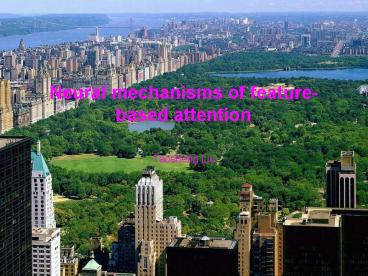Neural mechanisms of feature-based attention - PowerPoint PPT Presentation
Title:
Neural mechanisms of feature-based attention
Description:
Title: Neural mechanisms of feature-based attention Author: T Liu Last modified by: MSU Document presentation format: On-screen Show (4:3) Other titles – PowerPoint PPT presentation
Number of Views:71
Avg rating:3.0/5.0
Title: Neural mechanisms of feature-based attention
1
Neural mechanisms of feature-based attention
- Taosheng Liu
2
What is attention?
Everyone knows what attention is. It is the
taking possession by the mind in clear and vivid
form, of one out of what seem several
simultaneously possible objects or trains of
thought. -William James (1890)?
- Types of visual attention
- Overt attention
- Covert attention
- Spatial
- Feature-based
- Object-based
3
Attention and the brain
- Effects vs. control
4
Outline
- The effect of feature-based attention on visual
cortex - How does attention modulate sensory
representations? - The control of feature-based attention
- What is the source of control and how is control
implemented? - Attention and object recognition
5
The effect of FB attention to motion
Treue Martinez-Trujillo, 1999, Nature
- Questions
- Does feature-based attention modulate neuronal
subpopulations in the attended location? - If so, how does it correlate with behavior?
6
Use adaptation to assess feature selectivity
More adaptation for a upward test stimulus when
attending up vs. down
7
fMRI adaptation
- A voxel contains many neurons.
- fMRI adaptation can assess feature selectivity
within a voxel.
8
Adapting stimulus
play demo
9
(No Transcript)
10
(No Transcript)
11
(No Transcript)
12
Behavior tilt aftereffect (n8)?
Attend -20
Attend -20
Attend 20
Attend 20
13
fMRI adaptation protocol
Task inside the scanner report the orientation
of the test stimulus.
14
fMRI details
- Siemens 3T Allegra
- Surface coil
- 21 coronal/oblique slices
- 3 mm isotropic voxels
- TE 30 ms, FA 75º
- TR 1.2 s
- Bite bar to minimize head motion
15
Surface reconstruction and retinotopic mapping
16
Retinotopic mapping and localizer
real data (TL)?
17
fMRI response to the test stimulus
adapter
test
18
(No Transcript)
19
Attention modulation index
20
Correlation between behavioral and imaging results
21
A model relating psychophysical and imaging data
Psychophysics
Neural response
fMRI
Neural response
22
Summary conclusion
- Feature-based attention enhances activity of
neuronal subpopulations when the attended and
unattended features are processed in the same
retinotopic region. - Attentional modulation of orientation-selective
fMRI response adaptation. - Attentional modulation constant across visual
areas, suggesting a feed-forward mechanism. - Significant correlation between TAE and AMI only
in V1.
Liu etal, 2007, Neuron
23
The control of feature-based attention
- Components of attentional control
- Disengage/shift
- Engage/maintain
- Goal
- Separate different components
- Feature-based attention
24
Task and design
25
Sustained effect for motion
FEF, SPL/IPL sustained attentional control for
motion.
MT effects of attention for motion.
color to motion
motion to color
hold motion
hold color
26
Transient shift activity
Precu, IPS, PCG transient control of attention
shift.
color to motion motion to color hold
motion hold color
27
Summary
- Effects of attention
- MT (motion) and V4 (color)?
- Attentional control
- Transient control disengage/shift (superior
parietal lobule, left intra-parietal sulcus, left
pre-central gyrus). - Sustained control engage/maintain (frontal eye
fields, superior-inferior parietal lobule for
motion superior frontal gyrus for color).
Liu etal, 2003, Cerebral Cortex
28
Current and future plans
- Attentional control within feature dimensions
- What are the shift regions?
- What are the hold regions?--attentional priority
29
The representation of attentional priority
- Spatial attention
- Higher areas with a spatiotopic map send feedback
signals - Feature-based attention
- Are there neurons that encode the attended
direction in higher areas?
FEF
LIP
30
Decoding of brain activity Kamitani Tong
(2007)?
- Classifier scheme
- Classifier can reliably decode orientation
information in early visual cortex
31
Learning sequence of views of three-dimensional
objects
- The effect of temporal coherence on object memory
32
How do we recognize shapes?
Temporal association object views appearing
close in time are associated. Wallis
Bulthoff (1999)?
33
Harman Humphrey (1999)?
No accuracy effects
Attention? Effort? ???
7 views x 1 s/view x 3 repeats
34
Exp 1 - replication
stimuli
35
Exp 1 - method
36
Exp 1 - results
37
Exp 2 test novel views
Test views 1,3,5,7
38
Exp 3 method
39
Exp 3 - results
40
Exp 4
Encoding task preference rating rate how much
you like each sequence on a 3-point scale
41
Exp 4 - results
42
Summary
- RR always the worst
- temporal association works
- SS never exceeds SR
- temporal vs. spatiotemporal coherence
- SS depends on study time and intention
- potential confound































